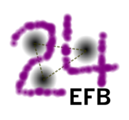Speaker
Description
The 0$^+$ excited state of $^{12}$C at 7.65 MeV is named after Sir Fred Hoyle, who proposed its existence in order to account for stellar abundances of carbon [1,2]. Aside from this astrophysical significance, it is thought to possess a curious $\alpha$-cluster structure. However, many questions still remain. To what extent can this state be described as three interacting $\alpha$-particles, and if so, what geometric configuration do they take $-$ a linear chain, equilateral triangle or something in-between? Is it that the bosonic nature of the $\alpha$-particle dominates the dynamics of this nucleus meaning that it could be the nuclear analogue of a Bose Einstein Condensate?
Since its discovery [3], measurements of the Hoyle state excitations and radius have provided indirect insights into its structure [4]. However, another way to examine its structure could be to examine the energy distributions of the $\alpha$-particles emitted during its rare three-body direct break-up [5]. Their relative energies in the final state could reflect the initial structure. Previous studies have set an upper limit on the branching ratio for the direct break-up process at 0.2\% [6].
We present a recent high statistics, low background measurement of the 3$\alpha$ decay of the Hoyle state \cite{Seven}. The $^{12}$C($\alpha$,$\alpha$)3$\alpha$ reaction at 40 MeV beam energy was measured using the Birmingham MC40 cyclotron. The particles were detected in complete kinematics and the upper limit on the direct break-up branching ratio was lowered by almost an order of magnitude compared with previous measurements. This places it below what is predicted by a number of theoretical models, opening new intriguing questions about the structure of this important state.
I will finally discuss the Optical Readout Time Projection Chamber (O-TPC) at HI$\gamma$S [8] and the previous determination of the direct 3$\alpha$ decay branching ratio of the Hoyle state 2$^+$ excitation [9]. This has allowed us to extrapolate down in energy and calculate a theoretical upper limit for the direct 3$\alpha$ branching ratio of the Hoyle state.
[1] E. Öpik, Proc. R. Ir. Acad. A 54 (1951) 49.
[2] E.E. Salpeter, Astrophys. J. 115 (1952) 326.
[3] D.N.F. Dunbar, R.E. Pixley, et. al., Phys. Rev. 92 (1953) 649.
[4] M. Freer, H.O.U. Fynbo, Prog. Part. Nucl. Phys. 78 (2014) 1-23.
[5] Ad. R. Raduta et al., Phys. Lett. B 705, 65 (2011).
[6] M. Itoh, et al., Phys. Rev. Lett. 113, 102501 (2014).
[7] R. Smith, Tz. Kokalova, C. Wheldon, J. E. Bishop, M. Freer, N. Curtis, and D. J. Parker, Phys. Rev. Lett. 119, 132502 (2017).
[8] M. Gai, et al., JINST 5 (2010).
[9] W. R. Zimmerman et al. Phys. Rev. Lett. 110

